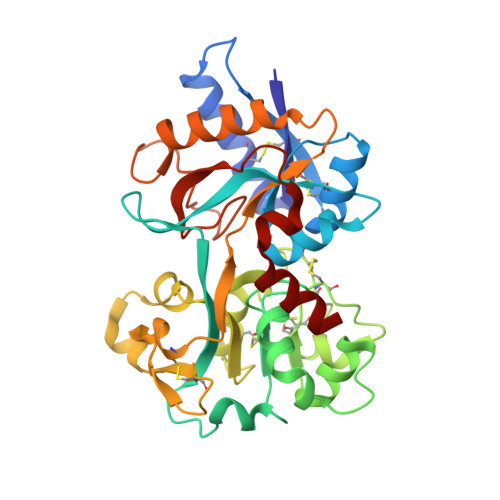The oxalate effect on release of iron from human serum transferrin explained.
Halbrooks, P.J., Mason, A.B., Adams, T.E., Briggs, S.K., Everse, S.J.(2004) J Mol Biol 339: 217-226
- PubMed: 15123433
- DOI: https://doi.org/10.1016/j.jmb.2004.03.049
- Primary Citation of Related Structures:
1RYO - PubMed Abstract:
A unique feature of the mechanism of iron binding to the transferrin (TF) family is the synergistic relationship between metal binding and anion binding. Little or no iron will bind to the protein without concomitant binding of an anion, physiologically identified as carbonate. Substitution of oxalate for carbonate produces no significant changes in polypeptide folding or domain orientation in the N-lobe of human serum TF (hTF) as revealed by our 1.2A structure. The oxalate is able to bind to the iron in a symmetric bidentate fashion, which, combined with the low pK(a) of the oxalate anion, makes iron displacement more difficult as documented by both iron release kinetic and equilibrium data. Characterization of an N-lobe in which the arginine at position 124 is mutated to alanine reveals that the stabilizing effect of oxalate is even greater in this mutant and nearly cancels the destabilizing effect of the mutation. Importantly, incorporation of oxalate as the synergistic anion appears to completely inhibit removal of iron from recombinant full-length hTF by HeLa S(3) cells, strongly indicating that oxalate also replaces carbonate in the C-lobe to form a stable complex. Kinetic studies confirm this claim. The combination of structural and functional data provides a coherent delineation of the effect of oxalate binding on hTF and rationalizes the results of many previous studies. In the context of iron uptake by cells, substitution of carbonate by oxalate effectively locks the iron into each lobe of hTF, thereby interfering with normal iron metabolism.
Organizational Affiliation:
Department of Biochemistry, College of Medicine, University of Vermont, 89 Beaumont Avenue, Burlington, VT 05405, USA.
















